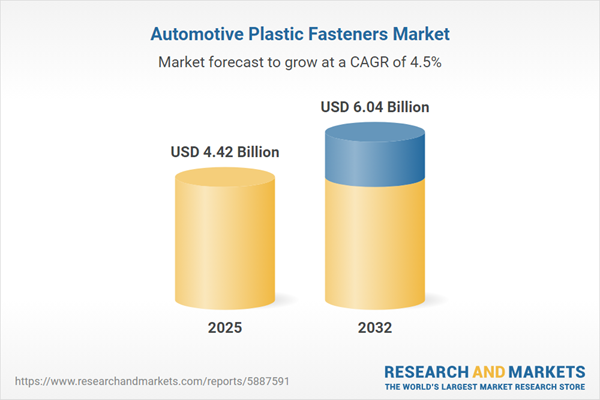Speak directly to the analyst to clarify any post sales queries you may have.
Automotive plastic fasteners are driving substantial advancement in vehicle design, offering pivotal solutions to manufacturers and suppliers as global markets adapt to rapid regulatory and technological shifts. Their evolving role ensures automotive companies can meet current and future operational challenges with agility and innovation.
Market Snapshot: Automotive Plastic Fasteners Market
The automotive plastic fasteners market is currently valued at USD 4.24 billion, with expectations to reach USD 4.42 billion by 2025. A compound annual growth rate of 4.53% is projected through 2032. Expansion is propelled by the adoption of advanced fastening technologies that enable manufacturers to respond effectively to vehicle innovation, electrification trends, and industry compliance requirements. Senior leaders are leveraging these innovations alongside improvements in process efficiency and enhanced supply chain structures to maintain competitive positions across regional and global markets.
Scope & Segmentation
- Distribution Channels: Tailored fastener solutions support both original equipment manufacturers and aftermarket distributors, simplifying assembly line integration and enabling deep-dive maintenance capabilities across varied automotive applications. This dual approach ensures flexibility during lifecycle management of vehicles.
- Material Types: Advanced engineered resins—including Nylon, Polyacetal, Polyethylene, and Polypropylene—deliver chemical resistance, high durability, and adaptable design, addressing rigorous performance criteria and operational longevity.
- Applications: Plastic fasteners are purpose-built for critical installation points such as engine bays, dashboards, door mechanisms, underbody components, and hose routing. This versatility extends component working life and supports broad vehicle system demands.
- Component Types: Offerings span bolts, screws, nuts, rivets, and clips. Each component secures assembly for both traditional and emerging vehicle architectures, enabling consistent reliability through demanding use cycles.
- Vehicle Categories: These fastener solutions are integrated across both passenger and commercial vehicles, including an expanding focus on electric and hybrid platforms as electrification influences product requirements.
- Regional Analysis: Companies address a spectrum of regulatory frameworks across the Americas, Europe, Middle East and Africa, and Asia-Pacific. Localized sourcing and adaptable supply models support compliance and operational efficiency within each region.
- Covered Companies: Notable established vendors—Nifco, Yachiyo Industry, TE Connectivity, Illinois Tool Works, Stanley Black & Decker, Fastenal, Bulten, Aptiv, and Forvia—distinguish themselves through reliable technical capabilities and a responsive approach to shifting industry conditions.
Key Takeaways for Senior Decision-Makers
- Lightweight plastic fasteners strengthen manufacturing efficiency and support adaptation to evolving international compliance needs and supply chain standards.
- Polymer advancements drive integration with new vehicle structures, fostering multifunctional capabilities and supporting continuous product development strategies.
- The shift toward electric and autonomous vehicle technologies is increasing demand for fasteners that secure vital subsystems, such as battery casing and drivetrain components, boosting operational reliability.
- Adaptive supply chain approaches stabilize business operations amid transitions between manufacturer and aftermarket channels, decreasing exposure to market disruptions and sourcing variability.
- Modern digital manufacturing techniques promote greater installation precision and traceability, reinforcing adherence to regulatory frameworks across geographically dispersed facilities.
- Supply chain efficiency trends originating from Asia-Pacific continue to influence global partnership models, cost control strategies, and supplier engagement, enhancing competitive positioning worldwide.
Tariff Impact and Strategic Sourcing Adaptation
Recent U.S. tariff changes impacting resin and fastener imports prompt organizations to reevaluate sourcing and supplier frameworks. Effective strategies now include expanding the supplier base, renegotiating contracts proactively, and exploring location alternatives for production. These actions help balance procurement costs and stabilize operational performance throughout complex manufacturing environments.
Methodology & Data Sources
This report combines executive-level discussions, expert interviews, structured secondary research, and patent review. Such a multifaceted research foundation ensures the analysis aligns with current market realities and reflects nuanced industry perspectives.
Why This Report Matters
- Provides actionable guidance on supply chain refinement and strategic adaptation to evolving market and regulatory pressures in the automotive sector.
- Delivers comprehensive analysis across relevant product, customer, and geographic segments, supporting informed innovation and process optimization.
- Supports risk management and procurement strategy development, equipping organizations to build sustainable operational resilience.
Conclusion
This report equips senior decision-makers with strategic market intelligence to enhance supply chain strength and foster innovation, as automotive plastic fasteners reshape the foundations of modern vehicle manufacturing.
Additional Product Information:
- Purchase of this report includes 1 year online access with quarterly updates.
- This report can be updated on request. Please contact our Customer Experience team using the Ask a Question widget on our website.
Table of Contents
3. Executive Summary
4. Market Overview
7. Cumulative Impact of Artificial Intelligence 2025
Companies Mentioned
The companies profiled in this Automotive Plastic Fasteners market report include:- Nifco Co., Ltd.
- Yachiyo Industry Co., Ltd.
- TE Connectivity Ltd.
- Illinois Tool Works Inc.
- Stanley Black & Decker, Inc.
- Fastenal Company
- Bulten AB
- Aptiv PLC
- Forvia
Table Information
| Report Attribute | Details |
|---|---|
| No. of Pages | 192 |
| Published | October 2025 |
| Forecast Period | 2025 - 2032 |
| Estimated Market Value ( USD | $ 4.42 Billion |
| Forecasted Market Value ( USD | $ 6.04 Billion |
| Compound Annual Growth Rate | 4.5% |
| Regions Covered | Global |
| No. of Companies Mentioned | 10 |









